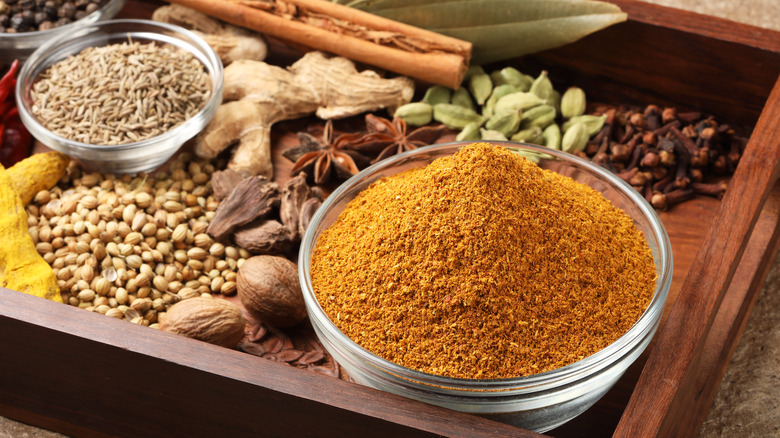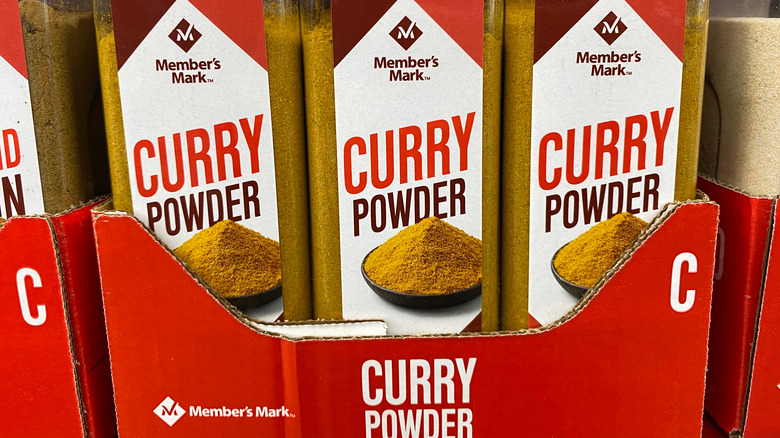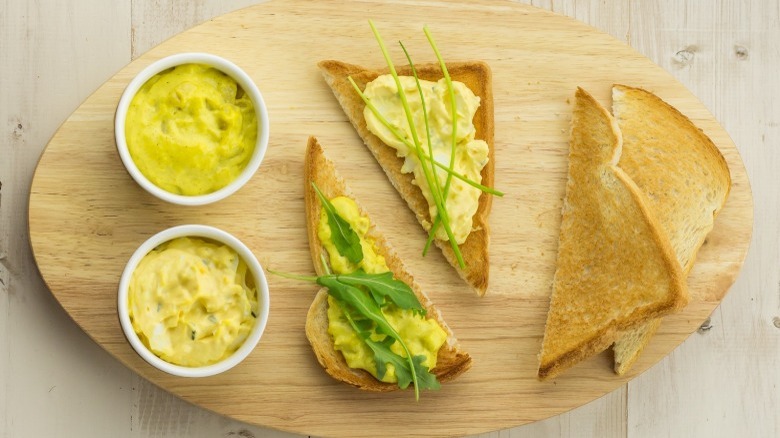The True Origins Of Curry Powder
If you like to keep your pantry well-stocked with dried herbs and spices including thyme, rosemary, paprika, and chile powder, then it's pretty likely that you've got a jar of curry powder in there, too. And if so, you may have taken a shortcut to the Indian-style dish known as curry, perhaps by mixing some of the spice blends into warm coconut milk and then cooking some chicken in it (via Yummy.ph). And even if the resulting plate is a tasty one, make no mistake — it's not Indian, because commercial curry powder isn't Indian.
According to Epicurious, defining curry powder is "almost impossible." You may have noticed when purchasing curry powder from several different brands, that almost every bottle on the market contains a different blend of dried herbs and spices. These will likely include turmeric, ginger, cinnamon, and mustard seed, but it truly varies wildly, according to The Spruce Eats. That's because curry powder is not one, standardized thing, but rather a very general adaptation of Indian flavorings based on the tastes of British colonial elites that started sampling regional Indian food during the Empire's occupation of the subcontinent starting in the 18th century (via Asian Century Institute).
Curry is a 'slippery term'
If you've ever eaten a good chicken or lamb curry, you probably associate these dishes with the southern Asian country of India. And so it would make sense that a bottle of curry powder could be used to make curry at home, but as Food & Wine explains, those little bottles of powdery yellow spices have little to do with true Indian cuisine. Instead, British imperialists who ate in the land — which they were actively conquering starting in the early 1600s (via India Today) — started referring to a wide variety of Indian soups, stews, and other dishes as "curries."
This became a catchall term for "a saucy dish with Indian flavors" that is still commonly used today in the U.K., according to The Spruce Eats. Imperialists likely got the word from the Indian Tamil "kari," meaning "sauce" (via The Human Element in Gastronomy). Eventually, adaptations of "curries" began making their way into British cookbooks. In 1747, one such cookbook described curry powder as "exceeding pleasant and healthful," per the British Library.
Taking a cue from the fact that traditional Indian recipes often make use of a carefully selected mix of fragrant spices, the British transmitting these approximations of curry powder were likely to mix together random spices that they thought could approximate Indian food, according to Food & Wine, which calls curry a "slippery term." Many of these early mixes haven't changed much up until today, where they're commonly found on supermarket shelves.
Ways to cook with curry powder
Even if the origins of commercial curry powder aren't the most authentic, there's no denying that a high-quality curry powder can be a "fast-track to a ton of flavor," as stated by Epicurious. The bottled blend isn't the best choice for making an authentic Indian dish from scratch — in those cases, you'll want to refer to a specific recipe's exact blend of spices — but bottled curry powder certainly has its uses in the home kitchen.
The mix can add a pleasant yellow hue and warming flavor to egg, chicken, and tuna salad. It can be worked into a creamy yogurt-based marinade for chicken, lamb, or fish, and can pack flavor into fresh mussels steamed in a vibrant coconut sauce. And if you really want to up your curry powder game before you get cooking, you can stir together a homemade blend, which helps assure the freshness of each and every fragrant spice.


